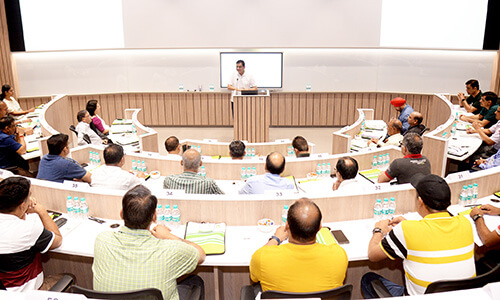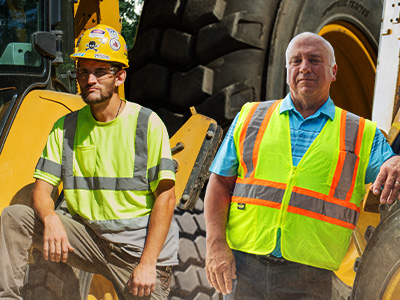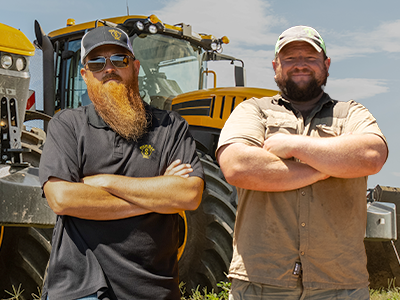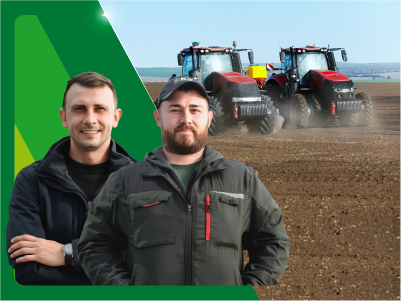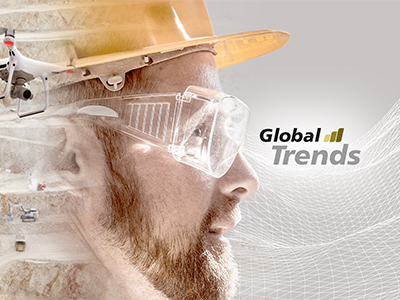Hello, and welcome back to Global Trends – the talk show covering YOUR industry with the purpose to entertain and inform.
I’m Saana Azzam and I’m your host. As we delve deep into what’s happening today and what matters for tomorrow in the global OTR sector.
But I’m not going to do this on my own, as you know we bring you the best and the brightest to educate, engage and empower. To turn to leading experts and commentators to help us navigate this world with confidence.
We want Global Trends to act as a launchpad for your own curiosity. Which is why, of course, we are closely integrating our social media feeds with this series of Global Trends. Follow our channels, join in the conversation, and see what our community has to say.
In the first two episodes, we covered the significance of technology, automation and robotics, before moving on to look at ways we can make the whole industry more sustainable.
At the beginning of the series, I pointed out how interlinked all our topics are – it’s impossible to look at them in isolation. And one of the recurring themes across episodes 1 & 2 was energy.
So, for this episode, we’re looking at Alternative Energies. How will mines of the future – even the near future – tackle their energy consumption?
Our experts, as usual, will help us navigate the topic – and be prepared to think laterally, because we’ve got some very interesting guests to hear from today.
Let’s find out who they are.
Let’s welcome to the studio Paul Muller, Perkins technical sales manager.
Paul has spent 20 years working in the development of off-highway power trains, he is the leader of the development of future power systems across electrification and low carbon intensity fuels.
Paul, come and join me.
Hi Paul, welcome to Global Trends.
Thanks Saana, it’s nice to be here.
Thank you for joining us. But, before starting our interview, I would like to invite you all to follow us on our social media channels, share your reactions and opinions and enjoy the episode with us!
Now Paul, Perkins is well known as a diesel expert – so what’s your story when it comes to Alternative Energies?
Thanks, Saana. You know, we’re best described as power systems experts. We see ourselves as part of the energy transition, and we are playing an important role in supporting our customers helping them navigate through a wide range of different technologies, trying to improve their efficiency, but also reduce their environmental impact. And one of the ways we’re doing that is by offering electric solutions.
Fantastic!
Yeah, it is something we’ve been doing for 25, 30 years, in terms of creating more efficient engines that reduce NOx and particulates, and now the focus is on reducing the greenhouse gas emissions as well.
Ok! Well, in playing a role in this energy transition, electrification is a major opportunity, of course. So, have you got some news for us with regards to that?
Yes, we have a new electric battery solution; it’s the first step – we have got a 300V and 600V modular system, where you can combine together multiple packs, to help some OEMs powers a lot of machines – and we also have a smaller 48V solution which is suited to smaller applications.
Ok. But electric’s not the only solution, right?
That’s correct, this is a very important point; you know, something we’ve been discussing with our customers. We see there is a wide a range of solutions; I don’t think electrification is going to be right for every solution and every customer, so we are looking at other alternatives as well which come with those environmental benefits.
And what are those alternatives you’re looking at?
Well, the first thing to say is that at Perkins we don’t believe reducing greenhouse gas emissions is incompatible with continued use of the internal combustion engine. We just need the right fuels.
So initially we are starting off with ‘drop-in’ fuels – these are straight replacements for diesel, such as synthetic diesel, HVO…
Ok, HVO?
So, yeah, HVO. It’s ‘hydrotreated vegetable oil’. You know, even though the tail pipes emissions are similar to that of traditional diesel fuels, HVO can reduce the overall lifecycle of CO2.
So, for a lot of operators, these fuels give them a kind of, let’s say, intermediate step?
Yes, absolutely. You know, scrapping a load of perfectly good machines isn’t very environmentally friendly either. If we could use these existing machines running them on fuels like HVO then when they have reached their end expected life they can be replaced with lower greenhouse gas emissions technologies in the future.
You know, there are a whole load of other alternative fuels to be investigated as well, hydrogen, DME, ammonia, ethanol the list goes on.
Fantastic! You mentioned hydrogen – that’s something that’s been talked about for a while, isn’t it? What’s happening with that?
Exactly, it’s something we’re actively working on, we have got a number of publicly announced projects in that area.
But we’re also looking at things like fuel cells, you know, I think initially this was mainly a start off in power generation solutions. But there are other opportunities in mobile machines, and people are looking into that as well.
And also then looking into the full electrification as we mentioned…
Now, we’ve heard how mine sites are often remote. The attraction for a lot of operators is being able to switch to energy sources that are self-generated – be a solar or wind. But can that energy then be stored as hydrogen?
Yes, it’s about how you take that renewable energy, you know and then working on how to store it, so if it is not a sunny day, if it is not windy you can store it and use it for the future.
You know, hydrogen is one of those solutions.
And again, something that earlier guests have mentioned: the importance of a lifecycle assessment.
Yes, definitely. So, a lot of people are talking about this – you need to look at the well to wheel is as it’s known – but also on other factors like the ESG elements around it: you know, where it’s made, how it’s been made, the knock-on effects, food versus fuel debates.
There’s a lot of different areas to think about, you can’t be just focused on a single technology, you need to look at everything that can take the whole impact into account, and the provenance of the fuel and where it’s coming from is really really important.
Let’s get back to electrification. Can you give me some examples on how that can be applied?
Yeah, it’s a really interesting subject, and mining is a great example to look at. So, electrification adoption is tied closely with the availability of infrastructure. Very small, compact machines are more likely to electrify, they’re better suited to it, especially in an urban environment, because they can get to infrastructure and it’s easy to plug them in.
But then at the other end of scale you have got the really large machines used in mining, quarrying applications. These sites are in place for a long time, so it’s worth putting in the investment, to put in the good infrastructure, including putting power in place. So, these types of machines in this area are likely to electrify as well.
Yeah, we’ve heard of examples where the bigger haul trucks are using an overhead power system – so they can benefit from using electricity, without the problems imposed on range and capacity by a pure battery-electric system.
Yeah, you know we’ve got examples where there is overhead power lines on the main haul roads, you know the trucks, as they pull off the main haul roads they’re regenerating energy from braking going down the hill to the quarry phase, and load up – which gives them enough energy to get back up the hill and get back onto the haul roads where they can connect back to the electricity lines, overhead lines and repower themselves and recharge. It’s a very neat solution.
You know, the key difference between the electric vehicles and the Internal Combustion Engines power vehicles is understanding the opportunity to recharge, it’s something they have to think about and look at how it could be done.
What are the engineering aspects of electrification? I’ll be it’s not as simple as taking out the diesel engine and dropping in an electric motor?
No, definitely not. Part of it is having that data – understanding usage, truly understand their application, and engineer it accordingly. If you don’t do that, the electric vehicle just doesn’t perform, and then the operator is just going to jump back into the diesel equivalent instead and not going to be part of that energy transition anymore.
So, the drop-in alternative fuels give us a transition to allow us to use the ‘old’ engineering mindset, an alternative energy like electric power demands a ground-up rethink of machine design, am I right?
It does, but that’s not a serious bad thing – it allows engineers to reconsider things and look at it differently to find out how we are going to improve and refine the equipment in use.
Paul, I suspect there’s plenty more for us to discuss, and you’re clearly the expert – but we are unfortunately out of time!
But before we go to the next guest, let me put you in the hot seat. We’ve asked our social media followers to submit questions to our guests; I’ve picked this one in our ‘Ask Away’ slot. Are you ready to go?
I think so, I’ll go from it.
Ok. The question asked is: Where does Perkins expect to be in five- or ten-years’ time, in terms of providing customers with electrified solutions?
Ha! Yeah, that has put me on the spot. It’s a tricky one. Where do we see it going? We’re ready to work with anyone who wants to work with us! But we see different regions moving at different speeds. You know, in certain areas we got large push for electrification, and we already expect the adoption rate there to be faster. You know, we supply engines globally and all the areas are moving at different paces.
There is certainly a lot learning that we can do, learning that’s needed before everyone can adopt these technologies. And to get them adopted you need to have the appropriate support in place – advice, engineering, parts, service – the maintenance technicians to work on these things. People take that for granted around diesel at the moment cause it’s been around for so long, but that’s something to work on going forward, and we can offer full support and give the confidence to those early adopters that their support is in place.
Tricky question, did I make you sweat?
Yes.
Well thank you for answering Paul!
Join us again for the discussion after we’ve heard from our next guest. We’ll be seeing you shortly.
Well, I told you at the beginning of the episode that we were going to think laterally on the topic of alternative energies.
And our next guest is someone who’s developed an ‘alternative energy’, but in a very different sense.
AutoStem Technology is a South African company that developed and innovative new blasting technology. Here to tell us more is Jonathan Cohen.
He is the Director of Product Commercialization for AutoStem Technology with 11 years of experience in the field of explosives. He headed a team that developed AutoStem Technology which is the only explosive technology available nowadays on every continent.
Jonathan, come and join us!
Jonathan, welcome to Global Trends.
Thank you, Saana.
Amazing, so let’s start right away. Why do we need a better blasting technology?
Ok, good question. Traditional explosives have been the same for the last 100 years.
In a traditional civil explosive, you’ve got a material that burns terrifically fast – up to 7,000 metres per second. But the speed of sound is only 340 metres per second, so once you have that flame front moving faster than the speed of sound, you have a shockwave.
Like a sonic boom from an aircraft?
It’s exactly right. In a tightly bound material such as rock, subjecting it to a shockwave produces a breaking phenomenon – essentially, the rock is shattered.
But that shockwave is uncontrollable. Nearer to the blast, you invoke a disproportionate amount of damage.
So, we asked the question – can we develop an explosive that functions without shockwave?
Then your inferred damage would be local exactly where you want it.
To some people, Jonathan, that might seem like an impossible ask. Surely that shockwave is a natural consequence of an explosion?
Well, we tried to decouple two variables which are seen as intrinsically linked: velocity of detonation, and effectiveness of the product.
OK.
By decoupling these variables, we developed something special. A product that can be used for civil operations – mining, construction, etc – without the consequences of conventional explosives, like shockwave and unwanted damage.
If you’re bringing down a building, or blasting rock, you want the local effect on rock but without damage to nearby structures, or tunnels, for example.
In underground mining, this is even more important. With conventional explosives, you pulverise the orebody. It’s typical to have upwards of 20 or 30 per cent of your high-value commodity pulverised during the blasting process.
So, the very act of blasting loses material?
Exactly right. It’s accepted and priced into the mine economics.
What percentage of the underground commodity – iron, gold, copper, platinum – is destroyed in blasting? If you’re running a mine where you’re recovering more than 80% of the commodity, you’re mining in a very sophisticated manner.
I see. But if you can avoid the shock phenomena…
…you don’t have the pulverisation effect and you’re not destroying your high-value commodity.
How do you do you that? How do you have an explosion that brings the rock out without a shockwave?
It’s a good question. That’s science: we looked at unconventional energetic materials, but which would still deliver a fast-burning speed. I’m not talking about 7,000 meters per second, more in the order of magnitude of 300 meters per second.
That’s quite a difference. How does it work?
To use explosives, you drill a hole in the rock. In an open-cast mine or quarry, your bench height will be 10 or 20 meters, in an underground mine you’ll have an advance per blast of maximum 5 meters. Pump that hole with conventional explosives, apply detonators and blast.
With AutoStem, you drill the hole, insert the cartridge. Once it’s activated, it releases a high volume of gas, confined within the rock – and that’s what creates the high pressure needed to break up the rock.
In addition a conventional explosive requires the blast to physically close the hole, with sand of gravel material before initiating the blast to confine the explosion; the AutoStem cartridge performs that function itself during its initiation! Hence, the word AutoStem.
And all of this happens without any pulverisation?
Absolutely.
Ok, so if I have understood this right, you’re forcing the rock apart, but doing it without that raw explosive power that creates the shockwave?
Yes, exactly.
We describe our technology as the world’s first non-detonating blasting product. We don’t even call it an explosive, because of the connotations with shock and wasted energy.
Your product would be a very disappointing firework?
Yes, very disappointing! But it’s an interesting point. The explosives world is dominated by seven large producers, essentially one on each continent. Practically, you can’t compete – how do you ship explosives from the US to Europe?
Our product, because there’s no shockwave, allows us to export it even on a passenger plane. It was an exhaustive process to achieve that UN categorization, but it’s now in the same class where you’d find a car airbag.
Jonathan, why would a company choose to switch to your blasting technology, rather than conventional explosives?
For every reason that we offer a technical advantage.
It’s safer – our product cannot detonate. You’ll find the miner who, all his life, has been handling violent and dangerous explosives and which do you think he’ll choose?
Yield-wise, a conventional explosive can never achieve the yields that you’ll get from our blasting technology.
Economically, you need none of the accessories required to set off your detonation. You cut out all the magazine requirements to store explosives. And permitting – that can take months to get the approval to have explosives on site, whereas our product can go anywhere in the world within 24 hours.
Sounds amazing!
Thank you. We’re the only company that can offer a blasting technology on every continent, which is something we are very proud of.
One of the most satisfying things is offering a demonstration, on site. With conventional explosives, you’ll have to set up an exclusion zone, 600m, a kilometre, maybe more. You’ll have to remove equipment, staff. You have to plan it in advance.
But what we’ll do is to take a huge boulder, put it in a front-end loader, and break it up with our cartridge. It will break that boulder in the bucket, without damage to the loader – showing just how focused that blast is.
Are non-detonating explosives the future of civil blasting?
We firmly believe so. We have patents, of course, but we’ll eventually have competitors. But in terms of the tech, the science, 20 years from today it will be the mainstream technology used.
What about training? Your product is currently deployed by those who’ve had explosives training…
Yeah, the guy who knows how to handle explosives, when he moves over to our product, we use the analogy that it’s like someone who’s trained to drive a 44-tonne heavy goods vehicle transferring to a MINI. It’s going to be easy.
Storage, transport and use of explosives are different in every part of the world but someone who knows how to use explosives will be fine with our product.
Let’s hark back quickly to our previous topic, where we looked at sustainability. Is your product more efficient in what it does?
Almost certainly. Side by side, our technology will use – in terms of mass – approximately 40 per cent less than the conventional explosives to achieve the same result.
Jonathan, this is a fascinating technology. It’s got our audience interested too – so let’s put you on the spot with a question taken from our socials… Are you ready for the question?
Bring it on!
Ok! Are there any environmental advantages to your product?
Sure.
By not pulverising your ore body, you increase yield. That’s better resource use. And the gas profile from our product is inert, unlike conventional explosives. That’s particularly important for productivity – you can get personnel back into the mine sooner, which means less energy expended in ventilating the mine to remove those gases.
Jonathan, thanks very much for joining the program. Stay with us – we’ll discuss more in just a moment.
Well, we promised you a sideways look at alternative energies. I think you’ll agree we delivered it.
Now, let’s go back to our guests for our studio discussion: Trends & Talks. Paul, Jonathan, let’s have you back in the studio!
And I’ve a third guest to introduce.
Welcome back to Global Trends, Piero Torassa, field engineer with BKT.
Piero has been working at BKT since 2010 and today he is Field Engineer Manager at BKT Europe. His job consists in testing tires – he monitors the tires’ performance and the quality of BKT’s products.
Welcome back to Global Trends, Piero, come and join us!
Gentlemen, delighted to have you all back! Piero, a very warm welcome to the show.
Yes, thank you!
I see you are excited; well, we are very excited to have you with us! You have been listening to Paul and Jonathan, I am sure, so let’s find out what do you think on this subject, too!
What I’d like to ask, now I’ve got the three of you together, is this: you’re all suppliers to the industry, so how can you best advocate or facilitate the adoption and integration of alternative energies?
Piero, let’s hear from you first.
Well, we need to think about energy efficiency overall. For suppliers like us, we need to assure our customers that the embedded energy consumed by the whole value chain, then we need to think about the energy that’s used not just digging material out of the ground, and in processing, but also what’s used to produce the equipment, the consumables, that makes it all possible.
So, with BKT as a tire manufacturer, what does that look like?
We are ourselves using renewable energy in the production of our tires. But we can also look at tire efficiency, ratings, load capacity, and so on. Normally, in OTR, we talk about star rating, which is the capacity of the tires to take load. Fifteen years ago, we were at one star rating, now we’re at three stars.
We also need to consider how these new energies affect our own products. Electric trucks, with their batteries, might need to carry more load. We need to change the rating – two stars to three stars.
These factors affect production and development. The carcass will be different, we have different belting, we need to reconsider the compound formulation.
In a very broad way, alternative energy means better efficiency. The same work in a reduced time, so we can increase productivity. The key thing is that we’re ready for the energy transition, to help our customers be ready for it too.
Great insight, Piero, thank you.
Jonathan, what’s your take on this?
Advocating for the adoption of alternative energy generation is the easy part - we all know that fossil fuels are finite and ultimately, future generations will rely on different energy generation technologies than that which we rely on today.
But with regards to facilitating the adoption of alternative fuels, I would say the only way to make this happen is really to get the incentives right.
Super, thank you.
Paul, over to you?
To facilitate and accelerate the adoption of alternative energy sources I think it is important to define the goal you want to achieve, the goals you are after, understand the real-world usage of your application and then work with a partner who can help develop and integrate a complete powertrain solution to meet these requirements. Unclear goals and not fully understanding how your applications are actually used may lead to the development of products that don’t meet customer needs which can discourage adoption.
That’s the perfect way to wrap it up - thank you Paul – and there we must leave it!
To the three of you, thank you for joining us today on Global Trends and sharing your knowledge and experience with our audience. We have Paul Muller of Perkins Engines, Jonathan Cohen from Autostem, and Piero Torassa of BKT – thank you, it’s been an absolute pleasure.
You’ll know by now that it’s time for our interactive session, where we ask you to answer a question from us!
First, last episode’s question. We asked you:
How much is the International Energies Agency predicting the lithium demand will be grown by 2050?
And so, the answer is: The International Energy Agency predicts a 26-fold increase for lithium by 2050.Now, if you thought it was 100-fold well, yes, that was a much earlier prediction and not their latest figures!
So, who got it right? I saw a few correct answers on the socials – well done!
For those of you looking to continue your unblemished score…here’s another one:
During the show Paul spoke about how Perkins has ensured its engines can work on HVO, a ‘green’ fuel. But what’s the chemical process needed to make HVO?
So, tune in next time – our last episode in the series – to hear the answer!
There we are, at the end of another episode. But not quite yet the end of the series: I’ll be back for Episode 4, when we’re going to look at Net Zero: how can we decarbonize the mining industry?
Thank you for tuning in, until next time!
